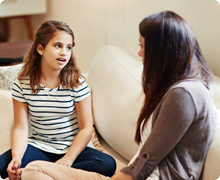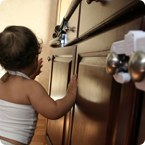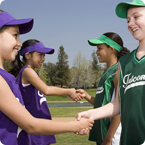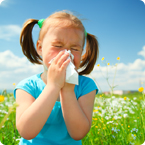Spring 2019
Healthy Family Communication
 Communication – the exchange of verbal and non-verbal information – is the foundation of relationships. Families who practice positive communication help their children develop trust, self-esteem and problem-solving skills that they will use their entire lives. So, how can we teach positive communication and help our kids make it a powerful lifelong habit? We can:
Communication – the exchange of verbal and non-verbal information – is the foundation of relationships. Families who practice positive communication help their children develop trust, self-esteem and problem-solving skills that they will use their entire lives. So, how can we teach positive communication and help our kids make it a powerful lifelong habit? We can:
Be active listeners and listen more than we talk. We can put away our phones, turn off nearby media, and give our child our full attention. We can nod, smile, touch, maintain eye contact and allow for pauses and silences – rather than jumping in with comments or advice. We can ask thoughtful questions to better understand our child.
Show empathy and stay calm. We can relax and absorb everything our child is expressing. We can put ourselves in their place and tune in to what they’re feeling. We can be sure our own frame of mind is compassionate, rather than judgmental.
Be clear, honest and kind with our words. Before speaking, we can consider the message we want to deliver and double-check our own intentions to be sure our message is gentle, helpful and necessary. Then, we can speak simply and from the heart.
Use ‘I’ statements rather than ‘you’ statements. For example, instead of telling your tween “You’re not getting to bed early enough, you’ll be tired tomorrow,” you can say something like “I’ve noticed your bedtime has been later recently, and I’m concerned that your body needs more sleep.”
Guide our kids to solve their own problems. For example, if a preschooler is having trouble putting her shoes on, you can sit beside her with your own shoes, and try something like this: “I have that problem too! Sometimes it helps if I first loosen my laces, like this. Want to try it with yours?” Then patiently encourage her while she figures it out. Guiding older kids often means listening carefully while they explain their problem in detail, then posing thoughtful questions to help them discover their own solution.
Positive communication creates a tight family bond that endures even after our children are grown and have kids of their own. It’s always worth the effort to improve our communication skills – and it’s never too late to learn!
Vaccine Safety
 Your child’s doctor wants you to know that vaccines are safe. Vaccines work, and they are necessary. The measles outbreak in Washington state shows why vaccines are needed.
Your child’s doctor wants you to know that vaccines are safe. Vaccines work, and they are necessary. The measles outbreak in Washington state shows why vaccines are needed.
To ensure safety, the Food and Drug Administration (FDA) reviews all aspects of every vaccine and will not license a vaccine unless it meets strict safety standards. After FDA review, a vaccine is also reviewed by the Centers for Disease Control and Prevention (CDC), the American Academy of Pediatrics, and the American Academy of Family Physicians. Only after being approved by all four groups is a vaccine officially recommended to be given to children.
The FDA and CDC continue to track the safety of licensed vaccines by collecting and analyzing safety reports through a system called the Vaccine Adverse Event Reporting System (VAERS).
If you have questions or doubts about vaccines, ask your child’s doctor. It’s always best to get health information from a medical professional.
Watch The Journey of Your Child’s Vaccine from the CDC to learn more about vaccine safety or read our immunizations page for tips on how to prepare your child for shots.
Poison Prevention for Kids Under 6
 In 2017, the Washington Poison Center dealt with 55,247 poison exposures of people, and children under age 6 accounted for almost half of these cases. This is alarming, especially considering that nearly 80% of the poisonings were unintentional.
In 2017, the Washington Poison Center dealt with 55,247 poison exposures of people, and children under age 6 accounted for almost half of these cases. This is alarming, especially considering that nearly 80% of the poisonings were unintentional.
The 10 most common substances that poisoned children ages 0 to 5 in 2017 were: cosmetics and personal-care products; household cleaning products; pain medicines; foreign bodies (including toys and miscellaneous items); skin creams and ointments; vitamins; plants; dietary supplements (including herbal and ‘natural’ products); antihistamines; and pesticides.
Nine out of 10 poisonings occur at home. Since kids are curious explorers who get into things they shouldn’t, it’s crucial to prevent them from finding household items that could be dangerous. Store poisonous items out of sight and reach when possible or use safety locks. And in case your child does ingest something harmful, be prepared by programming the toll-free Poison Help Number, 1-800-222-1222, into all your phones and be sure caregivers have it.
Watch our Poison Prevention Home Tour to learn more.
Prevent Non-Swim-Time Drownings
 Among children ages 1 to 4, drowning is a leading cause of death – second only to birth defects. Many parents are surprised to learn that when very young children drown, nearly 70% of those deaths happen when no one thought the child was supposed to be in the water.
Among children ages 1 to 4, drowning is a leading cause of death – second only to birth defects. Many parents are surprised to learn that when very young children drown, nearly 70% of those deaths happen when no one thought the child was supposed to be in the water.
Most non-swim-time drowning deaths among children ages 1 to 4 occur in an unoccupied swimming pool. Typically, a child walks or crawls away from adult supervision without being noticed. Drowning can happen quickly and quietly anywhere there is enough water. Young children also drown in ponds, lakes, rivers and other open waters when they wander off on their own. And every year in the U.S., about 20 children drown in buckets when they fall in head-first. In bathrooms, they can fall head-first into a toilet or climb into a full bathtub.
Prevent unsupervised access to water. Assess potential risks inside, outside and near your home and any other locations you visit, including other people’s homes, hotels or campgrounds. If a pool is nearby, ensure there is a secure barrier between it and your child. Empty all bathtubs, buckets, containers and kiddie pools immediately after use. For items that can collect water, always store them upside down. Keep bathroom doors closed and use a safety latch on toilets. And of course, during bath time, never leave a baby or toddler alone – not even for a second.
Learn CPR and basic water rescue skills. These can save a life when there is an emergency.
Get information about our CPR class or learn more about drowning prevention.
Stuttering
 Stuttering is common among toddlers and preschoolers, and it usually goes away on its own before long. A child who is developing a stutter may struggle to say certain sounds or words. They may repeat the first sound of words (like “buh-buh-buh-boy”) or stretch out sounds (like “ffffff-ast”) and pause noticeably between words. They may also show frustration when trying to get the words out.
Stuttering is common among toddlers and preschoolers, and it usually goes away on its own before long. A child who is developing a stutter may struggle to say certain sounds or words. They may repeat the first sound of words (like “buh-buh-buh-boy”) or stretch out sounds (like “ffffff-ast”) and pause noticeably between words. They may also show frustration when trying to get the words out.
For parents, it’s important to encourage the child, give them plenty of time to talk and don’t interrupt or tell them to slow down. Speech problems are easiest to correct before age 4, so if stuttering is frequent and doesn’t seem to be improving, see your child’s doctor, who may recommend a speech therapist.
Learn more about stuttering in preschoolers.
Sportsmanship
 Whether your child is just starting to play sports or has been competing for years, it’s always a good idea to talk about sportsmanship – and model it yourself.
Whether your child is just starting to play sports or has been competing for years, it’s always a good idea to talk about sportsmanship – and model it yourself.
Sportsmanship is about playing by the rules, enjoying the game, and showing respect to coaches, officials, teammates and opponents. It’s important to practice sportsmanship before and after the game, not just during. And since the ride home can be a sensitive time for young athletes, avoid discussing their performance, coaching decisions or a referee’s call. Follow their lead: if your child is silent, they probably need that silence. If they’re chatty, listen and engage.
No matter what – win or lose – let your kid know that you love watching them play!
A Cold or Seasonal Allergies?
 Colds and seasonal allergies share some symptoms, but there are distinct differences, too. Both can cause a runny nose and watery eyes. Both might cause a cough – but it’s less common with allergies. Seasonal allergies (also called hay fever) can trigger itchy eyes and nose; a cold does not. And seasonal allergies strike during pollen season: did your child have the same symptoms at the same time last year? While a cold may include a fever and sore throat, allergies do not. And cold symptoms last one to three weeks versus allergy symptoms, which last six to eight weeks for each pollen.
Colds and seasonal allergies share some symptoms, but there are distinct differences, too. Both can cause a runny nose and watery eyes. Both might cause a cough – but it’s less common with allergies. Seasonal allergies (also called hay fever) can trigger itchy eyes and nose; a cold does not. And seasonal allergies strike during pollen season: did your child have the same symptoms at the same time last year? While a cold may include a fever and sore throat, allergies do not. And cold symptoms last one to three weeks versus allergy symptoms, which last six to eight weeks for each pollen.
If you suspect allergies, visit your child’s doctor, who can make a diagnosis and create a treatment plan.
Quick Tip
Protect young children. Install guards or stops to limit windows from opening more than 4 inches.